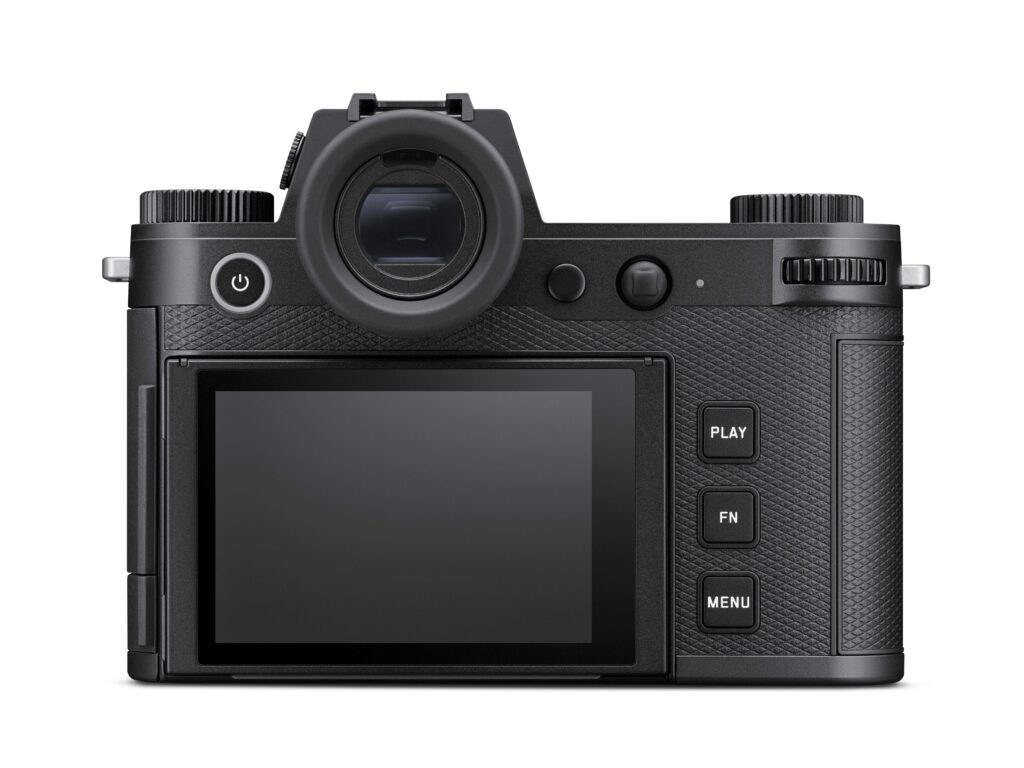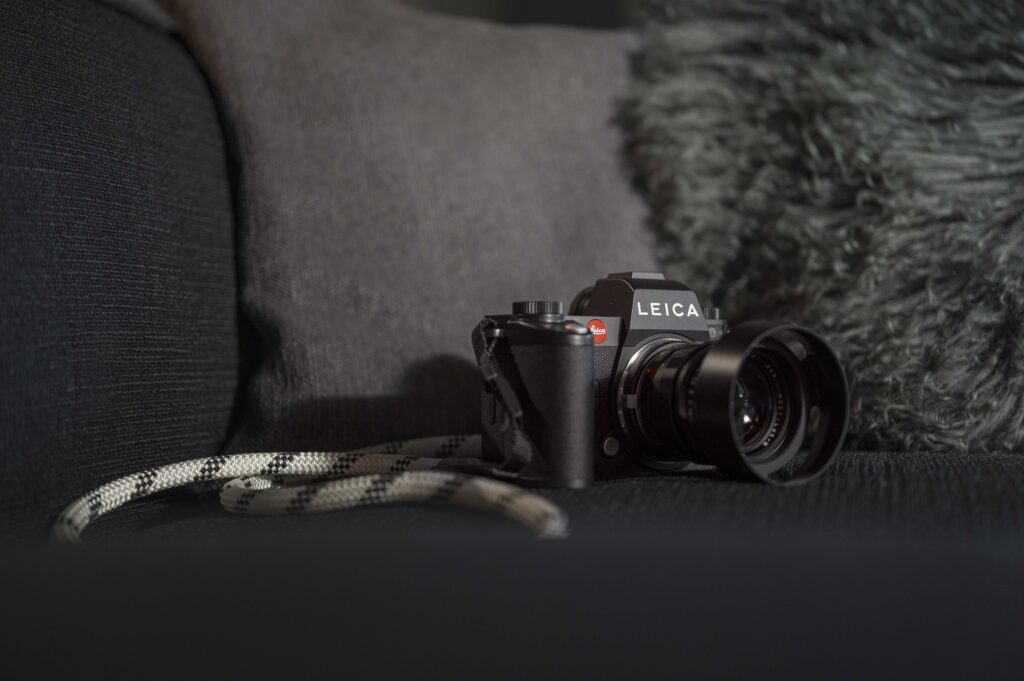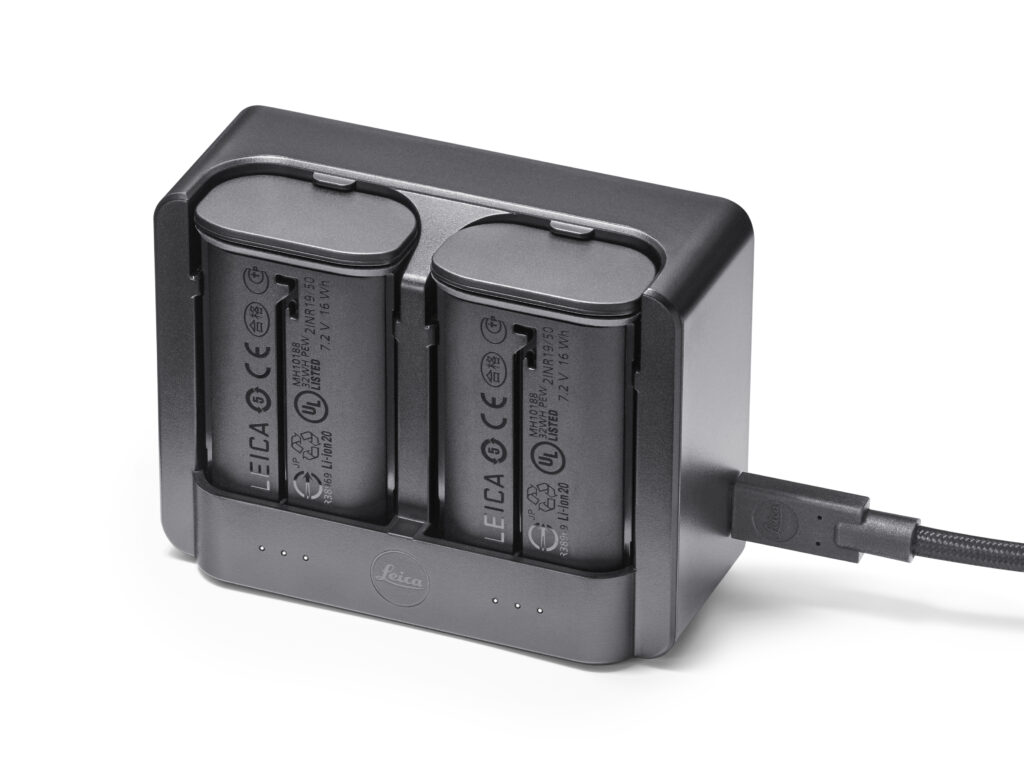The new Leica SL3 is here after months of rumour and speculation. It’s a few millimetres smaller and 76g lighter, but has changed in many more significant ways compared with the outgoing SL2. The camera features the 60MP sensor of the Q3 and M11, a faster processor, snappier autofocus and a tilting screen similar to that on the Q3. It has a new, simplified and more customisable menu system which now sets it apart from brand siblings.


There are minor changes to the control interface, including a new top dial and rearranged Play, Fn, and Menu buttons. In-body stabilisation remains the same as that on the SL2, as does the excellent viewfinder — although there is a small step upwards in read-screen definition. The camera boasts a new, illuminated push-button on/off switch, which some customers will hate, others might love. And, sadly, the SL3 does not incorporate the Content Credentials chip first seen on the M11 and which, we thought, would be a feature of most future Leicas. Finally, in a controversial move, the SL3 camera is shipped without a charger pod. A new two-battery unit is an optional extra.

Leica tells us that the SL3 is an extremely versatile camera, offering unprecedented image quality in both photography and videography: “it combines state-of-the-art technology, extraordinary design, and masterly manufacturing quality – more compact, lighter, and even more user-friendly than its preceding model. The new functions of the Leica SL3 are based on an ongoing dialogue with professionals, which is highly valued and cultivated by the company in the ever-changing world of photography”.

Body
As with the SL2, the body of the SL3 is all-metal, using magnesium and aluminium. It has the usual leatherette coating and is splash-water protected in accordance with the IP54 standard. There have been some subtle changes to the body, and the grip, in particular, to make handling more comfortable.
Overall, the camera shaves 4 mm off the width of the SL2, but it is 1 mm higher and 8 mm deeper (largely as a result of the grip). However, there is a weight saving of 76g, from 838g to 762g and this will be considered a significant saving. Leica claims that the result of the redesign and the lower weight results in a distinct impression that the camera is lighter and more handleable. It’s worth pointing out that the original SL body weighed 860g, so the SL3 is almost 100g lighter.

A big change is the addition of the tilting viewfinder, first seen on the Leica Q3. The screen itself is a back-lit LED unit of 2.3 million dots (slightly better than that of the SL2) and with anti-fingerprint and anti-scratch coatings. The top display, however, is the same 1.28in trans-reflective monochrome LCD seen on the SL2, although the menu content has changed.
Sensor, autofocus
The SL3 features the back-lit 60 MP full-frame sensor we have seen in the Q3 and is similar to that in the M11. It offers the same “Triple Resolution Technology”, enabling files to be saved in DNG or JPEG format in resolutions of 60, 36 or 18 MP. The dynamic range has been expanded to 15 stops and the ISO range is from 50 to 100,000.

The new hybrid autofocus system combines phase detection with depth mapping (Object Detection AF), and contrast recognition (Contrast Detection AF). The viewfinder is the same 5.76 million-pixel device seen in the SL2, and is generally regarded as being excellent, despite falling behind in resolution when compared with some other high-end cameras on the market.
The five-axis image stabilisation, offering an improvement of up to five stops, is the same as that in the SL2. The much-vaunted Content Creation chip of the M11, which we were told would feature in most future Leicas is mysteriously missing and is not mentioned in the press release.

Video is recorded in a resolution of 8K, supported by efficient codes such as H.265 and ProRes by Apple. A dedicated time-code interface allows for professional image and sound synchronisation on set. Throughout the process, the new Maestro-IV processor with L² Technology in cooperation with Panasonic handles the vast amount of data, with, according to Leica, exceptional colour rendition and low-light performance.
User interface
The user interface on the SL3 has undergone radical changes. An updated menu design, with more streamlined icons, is claimed to offer a clear structure and easier navigation. The distinct separation between photo and video modes is improved by a colour designation of red for photo and yellow for video. The Play/Fn/Menu buttons have been moved from the left to the right of the screen, and there is now an additional dial on the top plate. Leica claims that the changes to the grip, button layout and overall camera design will improve handling.

One controversial change is the replacement of the conventional power switch by a push-button surrounded by a ring of light to denote status. We imagine this will cause a fair amount of discussion, accompanied by a wailing and gnashing of teeth in some quarters.
The camera’s main functions can be customised completely to individual needs. The assignable FN keys and the optimised touch interaction in the menu add to intuitive operation. When photographing or filming, the SL3’s user interface aligns itself in landscape or portrait format, depending on the position of the camera. According to Leica, “thanks to the convenient handling, improved ergonomics, robust design, and IP54 certification, photographers can focus on capturing the shot in any weather and environment”.
Connectivity

The new interface and improved connectivity is aimed at smoothing the professional workflow. There are slots for CF Express type B and UHS-II SD and a USB-C port for data transmission, tethering and power supply, as well as full-size HDMI 2.1 output for external monitors or recording equipment.
Additionally, Bluetooth and Wi-Fi with MIMO technology are designed to ensure a stable and fast connection to the Leica FOTOS app. The Leica SL3, together with the included USB-C cable, are certified Apple “Made for iPhone and iPad”.
While there is no battery charger pod included with the camera, the company is offering a dual-battery accessory unit which works with the supplied AC adaptor and cable. Spare batteries and the dual charger are available separately, but also as part of a new set comprising battery, charger, AC adaptor, cable, and a collection of international plugs.
Accessories include a new handgrip and DC coupler. The coupler can be inserted into the camera’s battery slot to ensure a continuous power supply via USB-C. The new carrying strap and a hard-wearing wrist strap for the handgrip are also available.
The prices
The SL3 body will sell in the UK for a recommended price of £5,920, including Value Added Tax. It ships with one BP-SCL6 battery, USB cable, standard strap and a quick-start guide.
The accessory dual charger pod (without connecting cable or mains adaptor) will cost £135. However, a new USB-C Power Set — comprising a spare battery, a USB-C adaptor, the USB-C Dual charger, a connecting cable and a set of plugs for EU, UK, US, CN, AU and IN — is available at a cost of £320. The multifunction handgrip is £900, while leather wrist and hand straps are £85 and £190 respectively.
Here is a long-term review of the new Leica SL3, by Jonathan Slack
An in-depth look at the SL3 on DPReview
A review of the SL3 from techradar
What do you think of the change from a normal power switch to a push-button? And how do you view the trend to in-camera charging as the standard option?
Join the Macfilos subscriber mailing list
Our thrice-a-week email service has been polished up and improved. Why not subscribe, using the button below to add yourself to the mailing list? You will never miss a Macfilos post again. Emails are sent on Mondays, Wednesdays, and Fridays at 8 pm GMT. Macfilos is a non-commercial site and your address will be used only for communications from the editorial team. We will never sell or allow third parties to use the list. Furthermore, you can unsubscribe at any time simply by clicking a button on any email.


I’ve looked at these specs in some detail now but I still can’t see where on earth you put the film in. It may be that this Leica is not for me.
Hear, hear.
At the end of the day where will it stop up grading your Leica camera from your SL2 camera which I am very happy with I mean you spend thousands of pounds getting my Leica SL2 and then they bring along another Leica camera. It insane to keep up grading your Leica when you think another Leica camera going to improve your photography. Where will stop. I am happy with my Leica SL2 camera. It a sad world when you see photographers selling the Leica SL2 just because they think the next new camera will be better. When we all know it down to the person behind the lens.
Thanks Mike,
I got my paws on an SL3 yesterday and was able to compare it to an SL2. You can definitely feel the weight difference that the SL3 is lighter, and it feels as if the balance has changed for the better. This was with an SL 24-70 lens and an SL 50mm lens. It still feels heavy though!
What seems to have been improved are the display panels, both top and LCD. The details of the graphics is much better. The pull out screen works like the one on the Q3 and having pooh-poohed that before I got the Q3, I now think it’s helpful in certain circumstances.
The actual physical controls feel more precise too than the SL2, though that is subjective – all very Germany car-like, and being able to set aperture on the new left dial seems natural.
I wish I could say it was on my shopping list, but with a perfectly usable CL system still in the house, assisted with denoise programs, it’s hard to justify an upgrade just yet. What it did make me wonder was how many of the SL3 improvements might have made it to a CL2 and whether some of the firmware improvements might make it to the Q3 in the near future.
Hi Jon, FWIW, I can easily shoot 3-4 hrs non-stop with one of the Summicrons, the weight is not an issue, with the 24-90 I do get tired after 2-3 hrs, what I however am not willing to do, or perhaps better no longer willing to do, is to carry the SL with me, I did that for 3 years, it did not work for me, it is IMHO simply not a carry-everywhere camera, and then for me as a non-professional it becomes very hard to justify sinking $20-30K in a system that I cannot travel with, the body is too heavy, the lenses are way too heavy (for f2 lenses) but especially the combination of both is way way too heavy.
“than a fully articulating screen which would not have met the standards for robustness”
I don’t get this. The OMDS OM-1 (and its predecessors), for one example, has a fully articulating screen and is practically begging to be handled roughly – and I fully satisfy that desire. Never suffered any screen hinge damage. Honestly this design looks more open to damage if dropped at an unfortunate angle, as the limited articulation would only absorb shock by bending the struts.
But I guess Leica gets a soft ride on this site 🙂
This is the factory line. However, I tend to agree with you. The articulating screen in my Panasonic S5 works well and does not appear vulnerable.
Thanks for this great overview, Mike. I rarely feel the urge to upgrade when a new version of a camera I own appears on the market, but I have to say, this one is pretty tempting. As impressive as the Q3 is, I think upgrading from SL2 to SL3 is much more compelling than upgrading from Q2 to Q3. The interoperability of the SL3 with an excellent range of Sigma and Panasonic lenses, and of course, M-lenses, together with tilting screen, IBIS, improved autofocus, and slick menu system makes this an extremely impressive and versatile option. It will be interesting to compare handling versus the SL2. Looking forward to a hand-on review shortly! Cheers, Keith
Thanks, Keith. I also think this is a great upgrade, although I have the Q3 already. I approve of the menus and the controls, and I am intrigued by the push-button power switch. They must have done it for a good reason and I am keen to try it out.
A push button illuminated on/off switch. It must be result of Leica’s consultation with professionals. 🙂
The Red Dot Forum announcement implied that the change from a physical to an electronic switch was driven by a desire to gain electronic control over this function, which could thus be operated remotely by the fotos app.
Hi Mike, it will be a lust worthy camera for the tilting screen alone. My sweet spot for photography after owning both the SL2 and SL2-S is 20 to 24MP. If I need more pixels, I use my amazing Topaz Gigapixel software. This camera is a welcome new option in the SL line for those that desire or need the new features.
The original Leica SL weighed 847g. That was WITH battery though, so the Leica SL3 WITH battery is not lighter than the original Leica SL. It is about the same weight, i.e. Leica managed to get rid of the weight that was added to the SL2 by incorporating IBIS.
For interest’s sake, I did a comparison between the Leica SL3 and the Panasonic S5II. Initially, I was surprised by the SL3’s quoted weight, which is only a few grams heavier than the Panasonic. Then I realised Leica quote a wight without battery (who uses a camera without a battery?) while Panasonic are honest and give us a ready for action weight.
The Panasonic weighs 740g including battery. The SL3 is 850g including battery. The dimensions are 141×108×85 (Leica) compared with 134×102×90 (Panasonic). Of course, the SL3 should more realistically be compared with the S1 series rather than S5.
I agree, it is rather unfortunate and confusing what Leica is doing, typically camera manufacturers quote the weight with battery or they quote both weights, without battery and with battery. Leica also does the latter for both M and Q but somehow for the SL they only provide the weight without battery. It does not make much sense to me. As an original SL owner the weight of the SL3 (as mentioned almost identical to the SL) is not an incentive for me to upgrade
On a positive note: They are back to the original weight while adding IBIS, tilt screen, a massive 60MP with the needed processing power and a 2200mAh battery.
Not that I don’t like the 601 and a still believe that it`s a fantastic camera but in terms of spec sheet performance they are worlds apart.
The illuminated on / off switch will happily help drain your 2200mAh battery while looking pretty. .